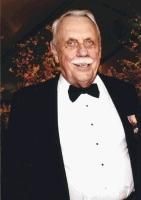
George was certainly one of our largest parishioners both in size at 6’4” and spirit, a proponent of moral justice. He was a big man in so many ways.
Van Sant, a distinguished retired Marine Corps colonel and longtime reservist, first came to Fredericksburg on a troop train during World War II. “When we stopped, people were waiting and handed us coffee through the windows of the train,” he recalled, his eyes growing wide 60 years later at the memory. “I never forgot that. I was so impressed with the people of the town.”
Van Sant was a long time volunteer – He served three years of combat duty during the Korean War. And from 1955 to 1977, he spent every summer on Marine reserve duty.
Van Sant’s Episcopal roots were deep. His father Dr. Edward R. Van Sant was a vestry member and church organist at Emanuel Episcopal in Alexandria. His son served two terms on the St. George’s Vestry in the 1960’s and then from 1989-1991 becoming Senior Warden in 1991.
Van Sant taught philosophy at Mary Washington for 32 years. His outstanding teaching was recognized by the Grellet C. Simpson Award, the highest honor accorded to faculty by the school.Van Sant served on numerous committees, ranging from curriculum and degree requirements to presidential inaugurals and the 75th anniversary celebration.
Van Sant ventured into politics was chairman of the Fredericksburg Democratic Party from 1975 to 1980, then resigned to run for City Council. With fellow council members Gordon Shelton, Lawrence A. Davies and Sidney Armstrong, among others, to get the land that now includes Central Park. He was instrumental in getting the Fredericksburg Area Museum and Culture Center established and was actively involved in the Old Town restoration effort. He discovered a flaw in the Commonwealth of Virginia “composite index” resulting in cities being unfairly funded for education.
Van Sant was a man of deep moral convictions. Former Mayor Davies said Van Sant went out of his way to make public displays of support for blacks back in the days when it took courage to do so. “George was always a strong supporter of civil rights,” Davies said. He remembered that after the assassination of Martin Luther King Jr. in 1968, Van Sant led a march from Mount Zion Church to St. George’s Episcopal Church “in an effort to keep the community from the rioting and division that happened in other areas.”
He said Van Sant also was involved in the birth of the Fredericksburg Area Community Relations Organization (FACRO), which worked to improve dialogue between the races. As a politician, “he was strongly supported by the black community because they felt he understood and was an advocate of people being treated equally,” Davies said. Van Sant resigned from the council then, in 1987, in part out of concern that the reduction in size would reduce black representation.
He was only known for his husky laugh and hospitality. Many games of volley ball were played in front of his home on Washington Avenue where he flung open his home to guests. George and family sat near the column on the right side of the church to the front.
Charles Sydnor who knew George for 30 years called Van Sant “a great champion of equality and justice—a mover and shaker of making the world a better place,”.. “He did it quietly, because it was right, because it was a good and just thing to do.”
Another memory From David Sellers:
“One Sunday morning, after Fredericksburg had been hit by an ice storm, Mr. Van Sant announced to the congregation at St. George’s Episcopal Church that the priest had not been able to make it in for the service because of the weather. But rather than advise the congregation to go home, Mr. Van Sant began to lead us in a rudimentary worship service. Because of his imposing size, voice, and moustache, and his array of titles (Marine Corps colonel, philosophy professor, city councilman, and church warden), I anticipated a certain pomposity in his demeanor.
But when he addressed the congregation–from the lectern, not the pulpit–he delivered a moving and sincere extemporaneous account of his own pursuit of both the life of the mind and the life of the spirit. I remember it after more than 10 years. George Van Sant is a physical, intellectual, and spiritual giant who has truly left his mark on Fredericksburg.
